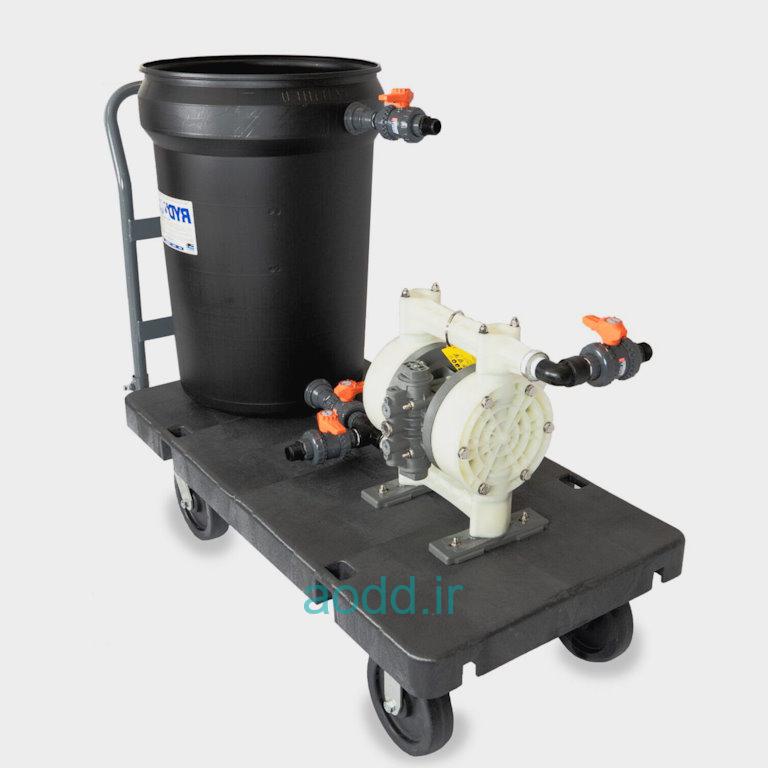The types of diaphragm pumps are generally as follows:

Diaphragm pumps are used in various industries because they can handle a wide range of fluids—whether liquid, viscous, corrosive, or containing solids. The drive type is one of the most important criteria for classifying diaphragm pumps, as it determines the operating conditions, efficiency, and maintenance and operating costs of the pump.
In this article, we examine the different types of diaphragm pumps from an energy perspective, explain the respective advantages and disadvantages, and discuss their possible applications.
1. Pneumatic diaphragm pump (air-operated double diaphragm pump – AODD)
How does it work?
These pumps work by regularly forcing compressed air past a diaphragm, creating a back-and-forth motion that sucks fluid in and out.
To use
-
Possibility of operation in potentially explosive environments (since there are no electric motors).
-
It can dry out without causing damage.
-
Suitable for corrosive and viscous liquids with solid particles.
-
Easy to care for and durable.
Shortage
-
A fully compressed air system is used.
-
Low energy efficiency due to high compressed air consumption.
-
Reduce the pressure (usually to 8–10 bar).
Inquiry
-
Chemical and paint industry.
-
Food and pharmaceutical industries (in compliance with hygiene standards).
-
ATEX or explosive atmospheres.
-
Empty the tank and use up the fluid that is causing the problem.

2. Electric diaphragm pump
How does it work?
In this type of pump, the diaphragm is driven not by compressed air but by an electric motor. The motor’s movement is usually transmitted to the diaphragm via a mechanical or electronic mechanism.
To use
-
It is more efficient than the pneumatic type.
-
No compressor or compressed air system required.
-
Flow rate and outlet pressure can also be regulated.
-
Less noise during operation.
Shortage
-
Sparks may occur in potentially explosive environments.
-
Reduce the dry run time.
-
We need reliable and safe electricity.
Inquiry
-
A system for supplying or delivering water.
-
Food, cosmetics and pharmaceutical industries.
-
Stations without compressed air infrastructure.
-
A project where low energy consumption is of utmost importance.
3. Hydraulic diaphragm pump
How does it work?
In these pumps, the diaphragm is moved not by compressed air or an electric motor, but by hydraulic oil . A piston or hydraulic pump transfers the oil pressure to the diaphragm, which in turn moves it.
To use
-
Can generate very high pressures (higher than pneumatic and electric types).
-
The flow and pressure adjustment is very accurate and convenient for measurement.
-
Excellent resistance to corrosive and toxic liquids.
-
Can be used in heavy industrial processes.
Shortage
-
The design is more complex and requires additional hydraulic systems.
-
The acquisition and maintenance costs are high .
-
Increased sensitivity to hydraulic oil contamination.
Inquiry
-
Oil, gas and petrochemical industries.
-
Chemical processes that require high pressure .
-
Pumping hazardous and sensitive liquids.
-
Precise dosing regimen.
RanPump B15-PX-2Z Pump Operating Manual
4. Hand diaphragm pump
How does it work?
This pump is controlled manually or via a mechanical pedal. The operator presses a lever or pedal to move the diaphragm and pump the fluid.
To use
-
Very simple and economical design.
-
No electricity or compressed air required.
-
Easy to carry and use in emergency situations.
Shortage
-
The power is very limited and the pressure is very high.
-
Its operation requires human resources.
-
Not suitable for heavy industrial work.
Inquiry
-
Transfer of small amounts of liquid in the laboratory.
-
Empty the small water tank immediately.
-
Marine and agricultural work under special circumstances.
5. Motor diaphragm pump
How does it work?
These pumps use a gasoline or diesel engine as a power source, the energy of which is transferred to the diaphragm via a mechanical mechanism .
To use
-
Complete independence from electricity and compressed air.
-
The ability to work in remote locations or places without industrial infrastructure.
-
Can pump larger volumes of liquid than manual types.
Shortage
-
Generation of noise and environmental pollution.
-
Fuel and engine maintenance required.
-
Not suitable for use in enclosed spaces or sanitary areas.
Inquiry
-
— Agricultural industry (pest control and irrigation).
-
Construction and mining projects in remote areas.
-
In emergency situations when power or compressed air fails.
General comparison of diaphragm pump types
| Pump type | energy | Working pressure | Efficiency | Main areas of application |
|---|---|---|---|---|
| Frame | compressed air | Up to 8-10 times | half | Chemical industry, food industry, explosive environments. |
| electric | Electricity | Up to 10-15 times | higher | Dosing system, compressorless unit |
| hydraulic | hydraulic oil | up to a hundred times | very large | Oil, gas and heavy chemicals industries |
| management | Arm strength | limited | fewer | Laboratory, emergency evacuation |
| combustion engine | Petrol/Diesel | half | half | Agriculture, construction and remote areas |
Finally
Diaphragm pumps are divided into several categories depending on the drive source: pneumatic, electric, hydraulic, manual and with combustion engine.
-
Pneumatic pumps are the best choice for explosive environments and aggressive liquids.
-
Electric pumps are more efficient and better suited for stations with a stable power supply.
-
Hydraulic pumps are used for high-precision dosing .
-
A hand pump is a cost-effective and practical solution for emergency situations.
-
Internal combustion engine pumps are very effective for remote areas and agricultural projects.
Choosing the right pump type depends on the fluid type, ambient conditions, required pressure, and infrastructure . Using a pump without a pump is not the best option. The decision should be based on the project requirements.